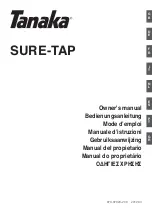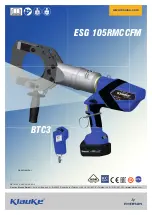
Section 1: Assembly & Set-up
AP-SC6072 Skid Cutter 327-321MK
4/6/21
12
Skid Steer/Track Loader
Requirements
The Skid Cutter is designed to attach to skid steer loaders
and track loaders with the following minimum
requirements:
Hitch Type. . . . . . . . . . . . . . . . . . . . . . . . . .ISO 24410
Rated Operating Capacity (50% of tip) . . . . . 3,000 lbs
Hydraulic Pressure Rating . . . . . . . . . up to 3,500 psi
High Volume Motor & Hoses. . . . . . . . . . . .18-31 gpm
Case Drain . . . . . . . . . . . . . . . . . . . . . . . . . Required
Skid Steer Weight. . . . . . . . . . . . . See warning below
Protective Operator Door
1
. . . . . . . . . . Polycarbonate
Notes:
1. A polycarbonate door can be purchased from your
nearest Kubota dealer. Refer to
WARNING
!
To avoid serious injury or death:
•
Lightweight power machines may need weight added to the
rear to maintain steering control and prevent forward
tipping or side tipping caused by a heavy front load. Consult
your power machine Operator’s Manual to determine
proper weight requirements and maximum weight
•
To protect the operator from thrown objects, the skid steer
or track loader MUST be equipped with a polycarbonate
protective door, and the operator MUST wear eye protection
such as safety glasses or goggles.
•
Consult your skid steer’s manual for operating capacity,
lifting capacity, and operating specifications. Exceeding
rated capacities and specifications can result in a roll-over
Dealer Preparations
WARNING
!
To avoid serious injury or death:
Allow only persons to operate this attachment who have fully
read and comprehended this manual, and who have been
properly trained in the safe operation of this attachment.
Serious injury or death can result from failure to read,
understand, and follow instructions provided in this manual.
Read and understand the Operator’s Manual for this
cutter. An understanding of how it works will aid in the
assembly and setup of your cutter.
This Skid Cutter has been partially assembled at the
factory. However, some assembly will be necessary.
It is best to go through the
this page before assembling the cutter. Speed up your
assembly task and make the job safer by having all the
needed parts and equipment readily at hand.
Ensure that the intended skid steer conforms to the
requirements stated under the heading
Uncrating
WARNING
!
To avoid serious injury or death:
Always secure cutter with an overhead crane, fork lift, or
other suitable lifting device before removing hardware bags,
shipping components, bands, lag screws, or hitch pins. The
1. Secure deck with an overhead crane, fork lift, or other
suitable means before cutting shipping support
bands and unbolting cutter from shipping crate.
2. Cut bands securing parts bags to the shipping crate.
3. Remove bolts securing hitch to the shipping crate.
4. Cut center band securing hitch to shipping crate.
5. Carefully lift cutter from crate and lower onto its skids
or onto support stands capable of supporting the
cutter.
6. Remove remaining components from crate. Discard
crate.
Torque Requirements
See
“Torque Values Chart”
on page 34 to determine
correct torque values when tightening hardware.
Pre-Assembly Checklist
Check
All hardware from the factory has been installed. If a part or
fastener is temporarily removed for assembly, remember where
it goes. Keep parts separated.
Be sure the parts get used in the correct location. By double
checking while you assemble, you will lessen the chance of
using a bolt incorrectly that may be needed later. Use Parts
Manual to identify location of parts you are unsure of where
they are used.
All grease fittings are in place and lubricated.
Miscellaneous assembly tools: hammer, tape measure,
assortment of wrenches and a level.
Have fork lift or hoist along with chains and safety stands sized
for the job ready for the assembly task.
Auxiliary weights (depending on skid steer
size).
Have a minimum of 2 people at hand while assembling.
Safety decals are legible and undamaged.
Loose parts bag/box shipped with the Skid Cutter.
Section 1: Assembly & Set-up
















































